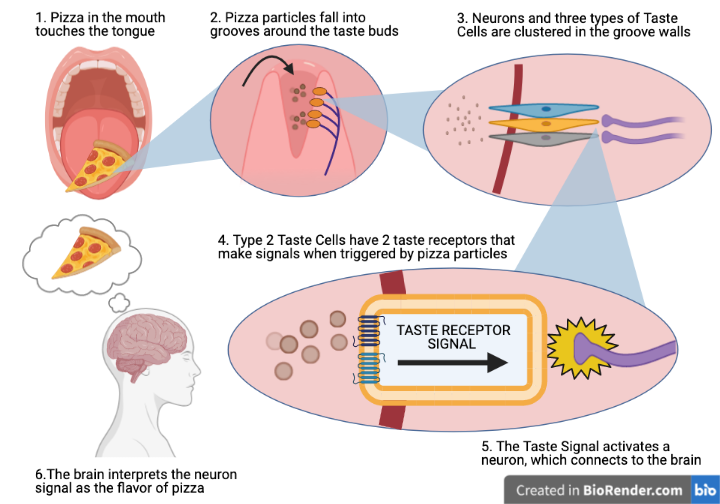How do we taste flavors?
Our sense of taste originally helped our species identify good food from spoiled or poisonous food, and is such a natural part of our modern lives that it is easy to take for granted. How is it that we can lose this fundamental sense when we get sick, for example with a cold or Covid-19? Just what exactly allows us to taste things? The diagram below walks us through how our senses work.

Imagine that you are eating a piece of pizza (#1 in the graphic above). As you chew the pizza slice, pizza particles make their way to the taste buds located on your tongue. Each taste bud has a series of pockets, or grooves, around it (#2), which trap some of these pizza particles.
At this point we have the pizza particles where they need to be, but if we want to actually taste them, we need to pause and focus on a special cluster of cells (the orange circles in #2) that are found in the wall of every taste bud groove. These clusters contain three types of Taste Cells, called Taste 1, Taste 2, and Taste 3 (as shown in #3). Each of these Taste Cells are responsible for allowing us to taste a particular flavor: Taste 1 Cells allow us to taste salt, Taste 2 Cells taste sweet, bitter and “umami” flavors, while Taste 3 Cells taste sour flavors. Notice that Taste 2 and Taste 3 cells have long purple structures to their right — these are neurons, cells that will send flavor signals to our brain. Interestingly, Taste 1 Cells (shown in blue at the top of #3) do not connect to a neuron; instead, they improve the flavor signals of the other Taste Cells. So when people say salt brings out the flavor of food, that is true even at the microscopic level!
Now that we understand the basics of taste cells, lets consider how they allow us to taste the pizza particles. Note in #3 how each Taste Cell sticks out a little from the groove wall. As the particles touch those exposed parts of the cell, a specific reaction occurs, as shown in #4. Here we are taking a closer look at the Taste 2 Cell; notice that in the left part of the cell, there are 2 looped structures. These are proteins called Taste Receptors, which are just one of the many chemical sensing proteins (collectively called “chemoreceptors”) I study. When these Taste Receptors interact with the pizza particles, they produce a Taste Receptor Signal within the Taste 2 Cell. This signal is sent to the purple-colored neuron; once this neuron is activated by a taste signal, it can conduct the final step (#6) of sending a signal to our brain that says “you are tasting pizza!”